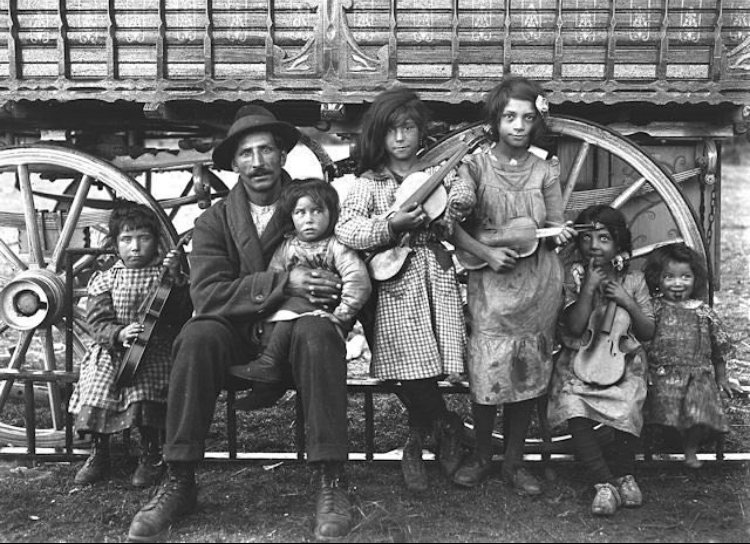8 January 2023
(Revised 10 January 2024: qualified the pejorative label and added the British to give/get gyp)
Gypsy is a term for the Roma, a traditionally nomadic people who probably originated in the Indian subcontinent and who have since spread throughout much of the world, with large numbers in Europe, North America, Brazil, and Argentina. The name gypsy has also begotten the verb to gyp, meaning to swindle or steal. The verb to gyp, meaning to swindle, is considered pejorative and should be avoided. And gypsy is considered by many to be pejorative, especially when used by non-Roma people.
There is also the apparently unrelated noun gyp, which in British usage means admonishment, pain, or annoyance, especially in the forms to give/get gyp.
The name comes from the false belief that the Roma originated in Egypt. Gypsy appears in English in the early sixteenth century in the form gyptian or gipcian. For instance, what may be the earliest recorded use of the term in English is in an account ledger for a parish in Kent. The entry for the year 1533 mentions a people with that name paying for a burial service and use of candles:
Itm receuyd of the gypcous for brekyng of the ground in the churche for one of their company, 7s. 6d. […] Itm receuyd of the gypcous for waste of Wex, 18d.
We have another use of the term, this time with the form Gipsy, that includes the false etymology in Geoffrey Fenton’s 1574 translation of a French Protestant religious tract:
But to the other Loytering & Idle poore, begging for the nonse, or by malicious sleight, they can not bée persecuted with too seuere correction, as either with the sentence of ye Gibbet, or at least condemnation to the Galleys. For some of them bée expert Théeues & Robbbers in the ende, as bée these countrey runners & stoute beggars, a people drawen togeather from many places, bearing the name of Gipsies, or Bohemiens, who, much lesse that they euer sawe Egipt, but knowe not where it standeth. These with their wiues, being sorcerors & interpretors of Sata[n], abuse the simple, & vnhappye, casting a powder into their purses whose vertue is to bring away al ye money: others there be called poore beggars, no more tollerable then they.
And we see the form that is dominant today, Gypsy, in a 1588 book on prophecy:
Euerie age, euery country, and euery toong, howsoeuer barbarous, or ciuill, affoordeth ynough, and ynough examples, both of the learneder, and vnlearneder stampe: but of what better credit, or more value, than the tales of Robin hood, or the fables of Robin goodfelow, & the Fairies, or the woonderous arts of Howleglasse, or the wizardly fortunetellings of the runnagate counterfet Aegyptians, commonly termed Gypsies?
Starting in the twentieth century, term gypsy, usually uncapitalized, started to be used to refer to people or professions that were itinerant in nature. We have, for instance, truckers referred to as Gyppos in the April 1912 issue of Outing Magazine:
The result of our inquiries was discouraging. It appeared that at the end of the road there were no “Gyppos” or “wheel-barrow outfits,” as they call the independent freighters, and the contractors refused to carry a pound that was not of their own.
And a gypsy cab is an unlicensed taxi. That usage dates to at least 1954 when it appears in a New Jersey newspaper:
3 Gypsy Taxicabs Chased in Hoboken
Hoboken, which always seems to have some sort of difficulty with its waterfront taxis, found its latest waterfront cab nuisance is the unlicensed, uninsured gypsy cab.
But criminal professions were often associated, both fairly and unfairly, with the Roma. Gip or jip is a slang term for a swindler or thief. The term appears in Allan Ramsay’s 1728 poem The Twa Cut-Purses. Although what exactly is meant in Ramsay’s poem is a bit uncertain. The term may actually refer to a Roma person, although there is no evidence in the poem to indicate this. And it must be noted that the Jip in the poem is not actually a thief but rather is unfairly accused of being one:
But wow? the Ferly quickly chang’d,
When throw their empty Fobs they rang’d;
Some girn’d, and some look’d blae wi’ Grief,
While some cry’d ont, Fy had the Thief.
But ne’er a Thief or Thief was there,
Or cou’d be found in a’ the Fair.
The Jip wha stood aboon them a’,
His Innocence began to shaw;
Said he, my Friends, I’m very sorry
To hear your melancholy Story;
But sure whate’er your Tinsel be,
Ye canna lay the Wyte on me.
(ferly = gossip, talk; girn = to grimace, to complain; tinsel = loss, damage; wyte = blame)
If the term in Ramsay’s poem does mean thief, it is a rare early use of that sense. The sense doesn’t come into its own until the latter half of the nineteenth century. There is, for example, this from Henry Hayman’s 1853 Retail Mammon; or, the Pawnbroker’s Daughter:
“How near the bone I lived!” he said to Hartup, afterwards. “A pound of dip-candles has lasted me a fortnight, and I often took my constitutional at night, that I might save daylight over my books. Never a man, I believe, found a gyp so honest, for never a gyp found a master too poor to rob!”
Alfred Trumble’s 1880 slang dictionary defines gip as “a thief.” And Robert Hunter and Charles Morris’s 1898 Universal Dictionary defines gyp as “a swindle or swindler.”
And around the same time, we start seeing the verb to gyp, meaning to steal or swindle. From the Philadelphia Times of 12 September 1879:
Yesterday, A. T. Schooley, of Allentown, walked into the office of the Chief of Police, shook the hayseed out of his hair, and stayed long enough to tell that he had been gypped an hour before out of $10 by a man who signed himself John Monaghan, at a stable in the rear of 714 Spruce street.
The British usage to give/get gyp dates to the late nineteenth century and is apparently etymologically unrelated to these other usages. An early example of this sense appears in the Leeds Mercury of 10 November 1887, 10 November 1887. The article is an account of coroner’s inquest into the death of an Albert Laister, who had apparently died of poisoning, either self-induced alcohol poisoning or murder by another toxin:
Mary Moody said she went to assist Mrs. Laister on the Tuesday morning. She then appeared to have had drink, and kept asking for some brandy. The children told witness she had taken two and a half bottles of brandy. She called Mr. Benson’s attention to her condition, and he replied that she must understand that his club was not for people who drank; it was for sick persons. Mrs. Laister had made herself ill, and he would give her “gip” when she did come to him.
This sense originated in Yorkshire dialect in the late nineteenth century. The Oxford English Dictionary says it is “probably” a development from the interjection gip, an expression of anger, remonstrance, or derision, but that dictionary notes the interjection had fallen out of use two centuries before the present-day usage appeared. It then says “perhaps” it is a contraction of gee-up, the command given to a horse. This seems equally unlikely. The origin of this one, therefore, can only be chalked up to “unknown.”
Discuss this post





